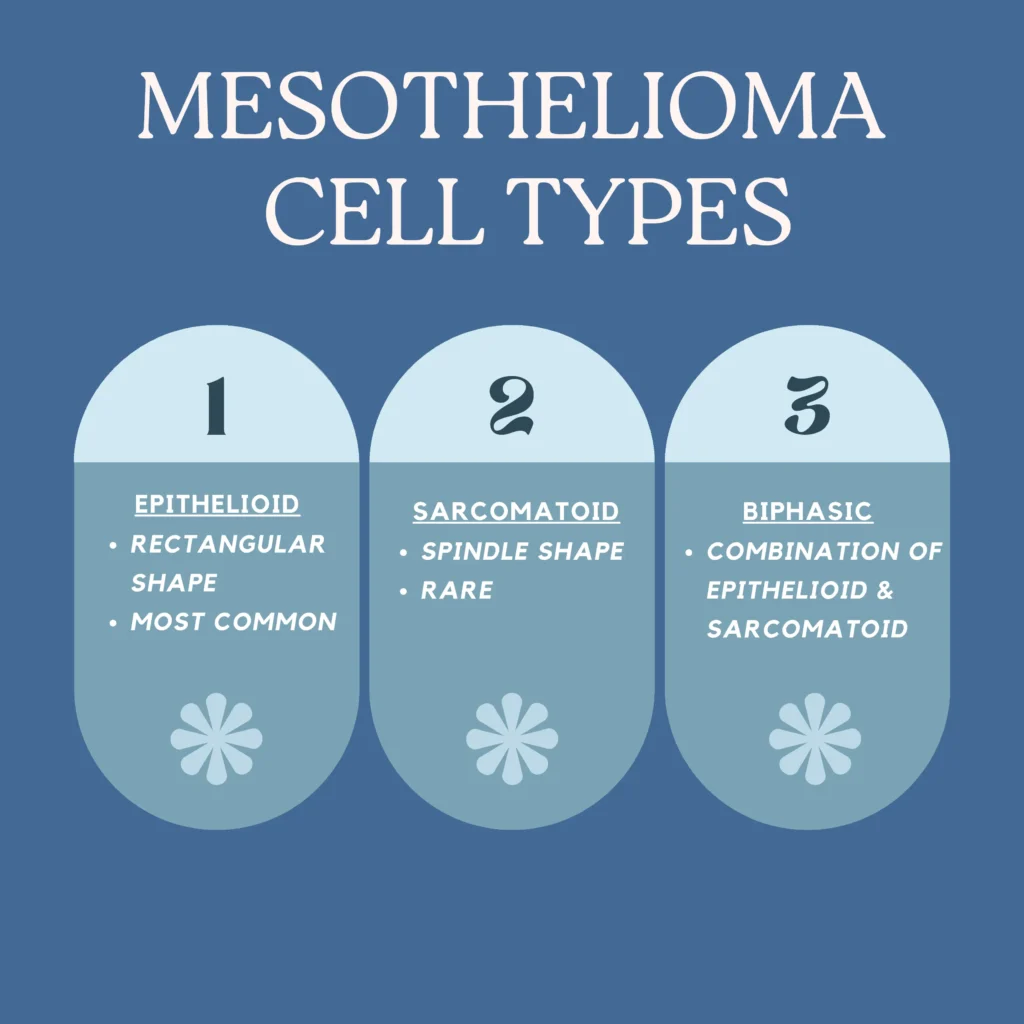Investigating not only the location of the mesothelioma but the type of cell initiated can reveal how to best approach treatment. There are three main cell types concerning mesothelioma: epithelioid, biphasic, and sarcomatoid (“Types and Grades of Mesothelioma”). Mesothelioma is a rare form of cancer that lines the mesothelial tissue. This type of cancer most commonly occurs in the lungs and abdomen but can additionally occur in the heart and testicles. Each cell type will be further described below.

Epithelioid
Epithelioid is the most common type of mesothelioma. Epithelioid sarcoma is a “type of cancer that starts as a growth of cells in the soft tissue” (“Epithelioid Sarcoma – Overview – Mayo Clinic”). Epithelioid cells are often rectangular and are different from sarcomatoid (“Sarcomatoid Mesothelioma, Symptoms & Treatment”). Due to the range of possibilities where this cancer can grow, the lungs, abdomen, heart, and testicles are all vulnerable to exposure. This makes up roughly “80% of patients” diagnosed with mesothelioma(Luka Brcic and Kern). While this number is vast there are multiple treatment options to minimize the effects and possibly even remove it. The treatments include surgery, radiation therapy, targeted therapy, and most commonly chemotherapy(“Epithelioid Sarcoma – Overview – Mayo Clinic”). It is recognized that the symptoms attached to this type of cell concerning mesothelioma can “mimic those of less severe respiratory conditions, such as asthma and pneumonia” (“Types of Mesothelioma”), but can include:
Sarcomatoid
Sarcomatoid tumors are a “type of cancer that looks like a mixture of carcinoma…and sarcoma”(“NCI Dictionary of Cancer Terms”). This is a fuse of cancer that begins in places like the bones and muscles as well as the skin and tissue. Additionally, out of the three different types of cells are the rarest and they are shaped like spindles which in hand impacts their abilities to conjoin. This incompatibility provides an easy way for the spindles to diffuse into other parts of the body (“Sarcomatoid Mesothelioma, Symptoms & Treatment”). The rapid spread further limits the treatment versatility and almost eliminates surgery but still embraces chemotherapy, immunotherapy, radiation therapy, and targeted therapy. It is recognized that most sarcomatoid mesothelioma diagnoses occur in the pleura (“Sarcomatoid Mesothelioma, Symptoms & Treatment”). This can lead to symptoms like:
Additionally, sarcomatoid mesothelioma makes up roughly “7% to 15%” of all mesothelioma diagnoses (“Mesothelioma – Introduction”).
Biphasic
Biphasic tumors are a combination of “different proportions of both spindle cells and epithelioid cells” (Liang et al.). Unfortunately, while this only makes up “10%-20% “of all diagnoses, the treatment options are often limited (“Mesothelioma – Introduction”). Given biphasic is a blend of both epithelioid(responds well to treatment) and sarcomatoid (responds poorly to treatment) it is believed that it impacts the treatment efficiency. It is additionally difficult to diagnose biphasic mesothelioma and the National Library of Medicine even claims that they are undiagnosed compared to epithelioid mesothelioma, which is over diagnosed (Luka Brcic and Kern). This difficulty arises in the “spindle cell component” and whether it is relentless or malignant (Luka Brcic and Kern). The Moffitt Cancer Center believes that the prognosis for the mesothelioma and treatment options will “depend on which mesothelioma cell type is dominant”.
Investigating both the location of the mesothelioma and cell type can help in selecting the best type of treatment. If you or someone you know has been affected by asbestos exposure or mesothelioma in the state of Pennsylvania, please fill out this form for a free consultation or call 1 (800) 505-6000 for legal help.
Sources:
- https://www.cancerresearchuk.org/about-cancer/mesothelioma/types-grades
- https://www.ncbi.nlm.nih.gov/pmc/articles/PMC7354152/
- https://www.mayoclinic.org/diseases-conditions/epithelioid-sarcoma/cdc-20392420#:~:text=Epithelioid%20sarcoma%20is%20a%20rare,which%20is%20called%20a%20nodule.
- https://diagnosticpathology.biomedcentral.com/articles/10.1186/s13000-022-01233-4#:~:text=Microscopically%2C%20biphasic%20hepatic%20synovial%20sarcoma,striated%2C%20fasciculated%20or%20herringbone%20shape.
- https://www.cancer.gov/publications/dictionaries/cancer-terms/def/sarcomatoid-carcinoma
- https://www.moffitt.org/cancers/mesothelioma/diagnosis/types/sarcomatoid-mesothelioma/